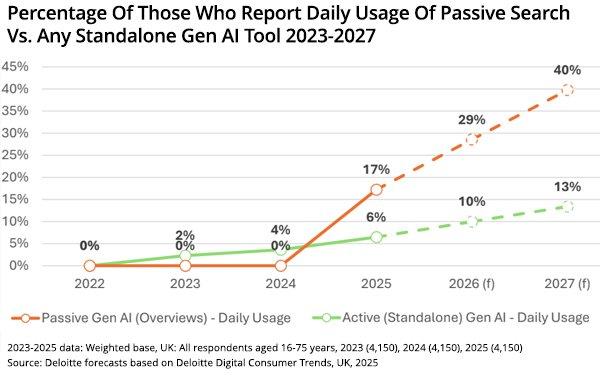
Google released Gemini 3, the latest update to
its AI model, on Tuesday.
Google CEO Sundar Pichai explained its reasoning capabilities and how the model
can grasp the depth and nuances of conversations.
The model can perceive subtle clues in creative ideas, or derive a conclusion of a difficult problem. And that is just the beginning.
AI is driving infrastructure investment, reshaping business models, and accelerating shifts in how people connect and consume content.
It is also driving how consumers visit websites, make
purchases and determine which products and services to buy.
But all this AI is creating a more competitive and complex digital economy, according to Deloitte.
“AI is becoming the
engine of digital business, spanning everything from generative creativity to agentic automation,” said Steve Fineberg, vice chair and U.S. technology sector leader at Deloitte.
“It’s reshaping how technology connects, how people search, and how value is created across the enterprise.”
advertisement
advertisement
Deloitte predicts that the number of generative artificial
intelligence users will surge in 2026, mostly attributable to existing applications that incorporate generative AI capabilities. More people will use generative AI when it is in an existing
application, compared with those who use a stand-alone generative AI tool.
The daily use of generative AI and how AI reshapes search, software, and storytelling while driving higher
demand for chips, compute power, and content is detailed in Deloitte’s 2026 Technology, Media & Telecommunications (TMT) Predictions report released today.
Daily use of AI in search
is expected to grow three times more than any stand-alone AI tool.
Nearly one in three adults in developed countries like the U.S. and the U.K. will view an AI-crafted search summary daily by
2026, but just 10% will use stand-alone AI applications daily,
It makes sense that passive use of generative AI -- with passive meaning the adoption of the technology in applications like
search -- will grow much faster than stand-alone tools.
For example, passive generative AI includes search, ecommerce, social media, and online news. This usage of generative AI inside
existing apps contrasts with traditional use of stand-alone generative AI apps like ChatGPT, Gemini, or Claude, which users open on their devices and use specifically to create an output such as text,
image, code, or another type.
According to Deloitte’s forecast, daily use in search will become 300% more common than in stand-alone generative AI tools -- even those with any one focus
such as text, audio, image, video, code, as well as those that process multiple modes at once.
In 2026, about 29% of adults will initiate one or more searches daily with results that
include a generative AI summary. This compares with 10% using any stand-alone generative AI app.
By 2027, 40% will use search overviews daily, versus 13% for any stand-alone generative AI
app.
The forecast focuses on one passive application for ease of comparison, and that use of GAI inside other applications will grow the most rapidly among groups that are currently relatively
low adopters, especially those in older age brackets.
Deloitte analysts believe that inference workloads will become “the hot new thing in 2026,” accounting for about two-thirds --
up from one-third in 2023.
The market for inference-optimized chips will grow to more than 50 billion in 2026.
But Deloitte also predicts that most of the computations will still be
performed on cutting-edge, expensive, power-hungry AI chips worth $200 billion or more, which will still mainly sit in large data centers valued at $400 billion or more, or on-premise enterprise
solutions worth $50 billion that use the same chips and racks as data centers, rather than on chips used in edge devices.
The lines between TV, streaming, and user-generated content
continue to blur. From generative AI video and micro dramas to video podcasts and collaborations between public service broadcasters and creators, new forms of storytelling will change how audiences
engage and participate.
Podcasting has been used for decades to attract consumers, but now has shifted from audio to video. One unnamed platform is now offering video on
over 60% of
top-rated shows in fall 2025. By 2026, Deloitte expects video-enabled podcasts to become even more prevalent as audiences seek more immersive experiences.
Deloitte predicts that annual global
ad revenue for podcasts and vodcasts will reach roughly $5 billion in 2026, up nearly 20% year-over-year.
Then there is something that Deloitte calls "microdramas" -- short, plot-driven
serials designed for smartphones. More than 500 million viewers watch this content annually. It blends convenience of short-form video with serialized storytelling.
In-app revenue for this
content is forecast to reach $3.8 billion in 2025, and Deloitte predicts that it will more than double to $7.8 billion by 2026.
While the U.S. is expected to generate half of global revenue in
2025, its share will likely drop to 40% as other markets increasingly capitalize on this trend.